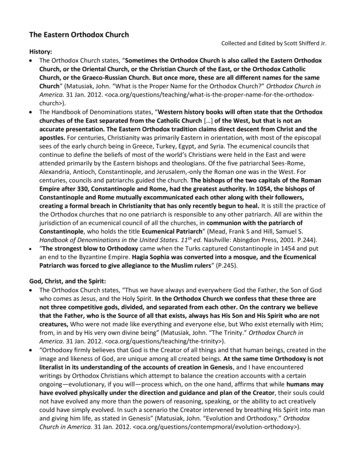
Transcription
SMALL CHURCH,BIG VISIONA PURPOSE DRIVEN SERIESHANDBOOK
TABLE OFCONTENTS1SESSION INFORMATION2SESSION 1 WITH DALE SELLERS5SESSION 2 WITH KARL VATERS7SESSION 3 WITH KARL VATERS9SESSION 4 WITH DALE SELLERS13ABOUT OUR SPEAKERS14RESOURCES
SESSIONSSESSION 1SESSION 3DON’T MISS THE MARKFROM THE START—FUNDAMENTALS FORHEALTH3 WAYS YOUR CHURCH CANBE MOST EFFECTIVE AT ITSCURRENT SIZEwith Dale SellersRoughly 95% of churches are small to mid-sized.God created all kinds and sizes of churches forall different kinds of people. Each church with aspecial and unique fingerprint. Identifying andunderstanding your church’s make up will maximizeyour ministry’s effectiveness. Journey with Karl ashe walks us through the principles of identifyingand utilizing your church’s DNA to be used for theGlory of God!with Karl VatersOften we look past the two most importantquestions we need to ask ourselves in ministry,“why does the church exist?” and “what part doesmy church play”? In our efforts to know the howto’s, we neglect the why. As we search for thepractical, we run past the foundational. Withoutclarity around mission, we can fall into doing thesame thing year after year with no greater impactand ultimately succumbing to defeat. Join DaleSellers as he helps us better define and gain clarityof mission so we don’t miss the mark!SESSION 4PROACTIVE VS. REACTIVE—LEADING YOUR CHURCHFORWARD FROM APROACTIVE POSITIONSESSION 2STOP THINKING LIKE ABIG CHURCH—EMBRACINGTHE STRENGTHS OF SMALLCHURCHwith Dale SellersDuring the pandemic, our leadership style becamehighly reactive, as we found ourselves operatingin survival mode. But since then, has leading incrisis mode become your norm? Do you feel likeyou’re constantly trying to keep the plates spinningso that none land on the floor and shatter? Maybeyou can’t work ON ministry because you’re sobusy working IN the ministry—reacting to everydetail and need. Imagine leading from a proactiveinstead of reactive position. A place wherestrategies, systems, and structures exist. Join Daleas he shares the priorities of leaders in proactiveleadership.with Karl VatersWithout question, big churches and small churchesare different. Certainly not in mission, but in howthey operate and are led. Differences in staffing,finances, resources, you name it. Stop trying tomirror the efforts of others and start embracingGod’s specific plan and purpose for your sizedchurch! Understand that ALL churches can makea significant impact no matter what the size. Joinus for this session as Karl explains the differencesbetween leading big and smaller sized churches.Same goal, different game plan!SMALL CHURCH, BIG VISION1A PURPOSE DRIVEN SERIES
SESSION 1 DALE SELLERSDON’T MISS THE MARK FROM THE START—FUNDAMENTALS FOR HEALTHASSESSMENTNOTESHealthy churches take an annual inventory to evaluate their impact andeffectiveness. An effective assessment asks the following:1. Do we understand God’s for His Church?The Great Commission tells us to go into all the .The Great Commandment teaches our is to love Godand love others.2. Are we clear on the mission and vision as the church leader?Mission defines we exist.Vision determines we are going and we are goingto get there.PRACTICAL STEPS TO DEVELOPING YOUR MISSIONTo gain clarity when defining your church’s mission:1. Define the ministry Jesus has placed within you.2. Do an of the leadership gifts of those you lead.3. Determine the and of the community around you.4. Develop a BEFORE you engage in a .STRUCTURE AND STRATEGY COME BEFORE SERVICEOne of the biggest misunderstandings that can drive leaders is the thought thatI’m being effective as long as I’m busy.“Activity does not always equal accomplishment!”God tells Ezekiel to speak to the structure speaking to the breath.The oil flowed as long as the widow brought a to hold it.Your mission and vision are the structure and containers create toaccomplish the purpose of your ministry, in the location you are currentlyserving, at this particular time in history.SMALL CHURCH, BIG VISION2A PURPOSE DRIVEN SERIES
SESSION 1 DALE SELLERSDON’T MISS THE MARK FROM THE START—FUNDAMENTALS FOR HEALTH (continued)WHAT STOPS PASTORS FROM UNDERSTANDINGTHEIR MISSION AND CASTING THEIR VISION?Three common reasons pastors fail to cast vision effectively, and how toovercome them:1. Getting stuck on past leadership .Personal failure has a greater impact on spiritual leaders than on mostpeople, due to the pressure and expectation to never miss the mark. Weoften forget that the majority of leaders in the Bible had some type of failure.Embracing failure is often the first step to removing the blinders that keep usfrom clarity of vision.God used Elijah in unbelievable ways to demonstrate His power and plan(1 Kings 17–19). However, Elijah came to a point of suicide because he wasexhausted from doing ministry. Twice God asks Elijah this question,“What are you doing here, Elijah?” — 1 KINGS 19: 9, 13Return to a path of renewed vision and healthy leadership by asking thesame question of yourself when facing failure:How did I get to where I am today?·events led to my failure?·influenced or intimidated my life in a negative way?·did I begin to sense that I was heading down the wrong path?2. Leading from .“Insecurity may be the most detrimental attribute a leader has to overcome.The insecure leader may attempt to be intimidating and aggressive, ormay be indecisive and passive. No matter how they react, the focus of theinsecure leader’s vision is more upon trying to hide their insecurity fromthose around them instead of where they want to lead the ministry.”3. Leading without sufficient .The vast majority of pastoral training focuses on biblical understanding andcommunication. The reality is most leaders have never been trained now toactually lead! Take heart, there are unlimited resources available today tohelp us learn how to be more effective leaders.SMALL CHURCH, BIG VISION3A PURPOSE DRIVEN SERIESNOTES
SESSION 1 DALE SELLERSDON’T MISS THE MARK FROM THE START—FUNDAMENTALS FOR HEALTH (continued)OBSERVATION: I’ve observed throughout my ministry that many churches don’t like todevelop a strategy. For some, the word strategy seems unspiritual. If this is you, thenlet’s change the word strategy to plan. Planning is not unspiritual. Yet so many churchesrefuse to develop a plan.TWO MISCONCEPTIONS AND THREE REASONSCHURCHES AVOID A STRATEGY/PLANMany spiritual leaders believe that it is somehow compromising to use solidbusiness principles in the strategic development of the church.Believe strategy quenches the Holy Spirit’s .Believe developing a strategy is using .It requires in evaluating current conditions and effectiveness.It can “rock the boat” of our current .It forces .“Writing down the strategy does not necessarily mean I’ve figured outeverything, but it does put a methodical process in place that moves me closerto accomplishment.”REFLECTION1. Where do you struggle most in understanding your mission and vision?2. What is the process you use to communicate and/or cast vision to your staffand congregation?3. Do those closest to you understand why your ministry exists?4. What measures do you have in place to measure your mission/visionprogress?SMALL CHURCH, BIG VISION4A PURPOSE DRIVEN SERIESNOTES
SESSION 2 KARL VATERSSTOP THINKING LIKE A BIG CHURCH:—EMBRACING THE STRENGTHS OF SMALL CHURCHTHERE ARE TWO TYPES OF SMALL CHURCHESThe church of , give or take 50, and the church of , give or take 50.The church of is far more common than the church of or 2,000.WHAT IS THE GRASSHOPPER MYTH?The false impression that our small church ministry is less than what God says itis because we ourselves with others.“All the people we saw there are of great size We seemedlike grasshoppers in our own eyes, and we looked the same tothem.” —NUMBERS 13:32–33THREE UNDENIABLE REALITIES OF CHURCHMINISTRY1. 80–90% of churches will never be larger than people.2. Virtually all pastors will pastor a for at least some timein our ministry.3. You can lead a small church without settling for .The church needs to embrace its “ .”SMALL CHURCH, BIG VISION5A PURPOSE DRIVEN SERIESNOTES
SESSION 2 KARL VATERSSTOP THINKING LIKE A BIG CHURCH—EMBRACING THE STRENGTHS OF SMALL CHURCH (continued)PRINCIPLESNOTESSmall is not a , a , or an .Bigger fixes .Pastoring a small church is not a for doing something .It’s a , and it’s worth doing .REFLECTION1. As a small church pastor, how do you define success in ministry? As you thinkabout your answer, be mindful of not falling into the trap of comparison.2. In what ways could your church redefine quality in ministry? How would thislook different than what quality looks like in a big church?3. Have you ever thought of your church’s small size as a problem? A virtue? Oran excuse? If so, what would it take to change that attitude?4. Leading a small church isn’t for everyone, just as leading a large church isn’t.Each is unique to lead and requires a specific gift set. Not based on yourcurrent circumstances, which do you believe you’re called to lead?SMALL CHURCH, BIG VISION6A PURPOSE DRIVEN SERIES
SESSION 3 KARL VATERS3 WAYS YOUR CHURCH CAN BE MOST EFFECTIVEAT ITS CURRENT SIZE3 MAIN THINGS WE NEED FOR CHURCHEFFECTIVENESSNOTES1. Realize your church can be an church.Over of our churches are under 200, over are under 100.My first reaction: !My second reaction: ?My third reaction: ?People will come to small churches, but they won’t give up to do so.looks different in a small church than a big church.2. Discover how churches function differently from churches.Many big church don’t translate well to a small church.SMALL CHURCH, BIG VISION7A PURPOSE DRIVEN SERIES
SESSION 3 KARL VATERS3 WAYS YOUR CHURCH CAN BE MOST EFFECTIVEAT ITS CURRENT SIZE (continued)THE LAW OF LARGE NUMBERSNOTESThe the crowd, the more they behave.3. Understand and use the DNA of your small church for God’s.THE FLIP SIDE OF THE LAW OF LARGE NUMBERSThe the crowd, the more each person has—for goodand bad.Big church leaders prioritize , , and .Small church leaders prioritize , ,and .THREE STEPS TO CHANGING SMALL CHURCHCULTURE1. the culture.2. Show them what you about the culture.3. They will give you permission to with them inmoving the culture forward.Don’t what your founders . like your founders.REFLECTION1. What would it look like if you started thinking like a healthy small churchinstead of obsessing over becoming a big church?2. Have your church’s resources ever felt like the table of random materials inApollo 13? How can you work with what you have and who you have moreeffectively to honor God and serve people?3. How might the Law of Large Numbers change the way you think aboutchurch leadership?4. What would it look like if your church was more intentional about prioritizingrelationships, culture and history?SMALL CHURCH, BIG VISION8A PURPOSE DRIVEN SERIES
SESSION 4 DALE SELLERSPROACTIVE VS. REACTIVE—LEADING YOUR CHURCHFORWARD FROM A PROACTIVE POSITIONJESUS TEMPLATE FOR THE NEW TESTAMENT CHURCHAND OUR CALLINGThe apostle Paul gives us the intended structure for how Jesus wanted hischurch to be formatted. The promised results of following his instructions are:An atmosphere of ongoing and both deepand wide.The intent of how healthy churches are led and function has never been aboutthe pastor and/or staff doing the work of the ministry. Churches that are actuallyhealthy are defined by their ability to their members for success fortheir ministry.Proactive leaders are .They understand:1. clarity of direction.2. those they lead to recognize their individual gifts.3. up leaders to hand the ministry off to in the future.Reactive leaders are .They prioritize:1. everything themselves in order to fill an inner need.2. people out of a desire for security.3. the status quo due to fear of change.Results of Proactive LeadershipResults of Reactive Leadership1. (v. 13)1.2. (v. 14)2.3. (v. 15)3.4. (v. 16)4.SMALL CHURCH, BIG VISION9A PURPOSE DRIVEN SERIESNOTES
SESSION 4 DALE SELLERSPROACTIVE VS. REACTIVE—LEADING YOUR CHURCHFORWARD FROM A PROACTIVE POSITION (continued)HIGHLIGHTS FROM GIDEON’S STORY THAT MAYRELATE TO OUR LEADERSHIP STYLE (JUDGES 6:11–15)1. The nation was or by a massiveenemy invasion.2. God sent a messenger with a word to tell them that was comingsoon through Gideon’s leadership.3. The Angel of the Lord appeared to Gideon while he was threshing wheat in awine-press. His response was instead of .God speaks to the that is inside his life.Gideon cuts down the idols and repairs the altar to the Lord.4. The people actually got at him and wanted to kill him.If you take a leap of faith then you’ll experience the crash of reality.5. The of the call was right on time.God told him his army was too big (32,000), so he cut it down. God said a bigarmy would take credit for themselves of what God was about to do. Gideoncuts it down from 32,000 to 10,000 to 300.“God said to Gideon, ‘you have too large an army with you. I can’tturn Midian over to them like this, they’ll take all the credit saying, ‘Idid it all myself,’ and forget about me.’ ” —JUDGES 7:26. Gideon’s army routed their enemy because they God’sinstruction.7. The nation was at under Gideon’s leadership.8. However, as soon as he died, the people went into thesame old things.9. Even though Gideon’s generation a miracle, they failed topass onto the next generation how to the miracle.*Gideon slipped back into a reactive leadership style once everything calmeddown. He failed to adopt the proactive posture needed to continue withvisionary, intentional leadership once entering into a season of peace.SMALL CHURCH, BIG VISION10A PURPOSE DRIVEN SERIESNOTES
SESSION 4 DALE SELLERSPROACTIVE VS. REACTIVE—LEADING YOUR CHURCHFORWARD FROM A PROACTIVE POSITION (continued)THE REALITIES OF REACTIVE LEADERSHIPCommon traits of a reactive leader:1. The reactive leader tends to lead from a place of insteadof .2. The reactive leader usually leads their organization to become.3. It takes situations for the reactive leader to step up.4. momentum consistently appears as the reactive leaderfocuses on past hurts.3 THINGS THAT PARALYZE THE REACTIVE LEADER1. The fear of .2. .3. Holding onto past .PROACTIVE LEADERSHIP PRIORITIESThe realities of proactive leaders:1. The proactive leader defines the behind activities. Ask whyabout everything you do as often as you can.2. The proactive leader draws strength from God’s . Faith comesby hearing God’s Word.3. The proactive leader recognizes that sometimes it takesto move us along. We can see many times in historythat God allowed the pressure to build to get His people to do what He hadtold them to do.4. The proactive leader stops God’s to worka miracle on their behalf.5. The proactive leader tends to themselves for success.SMALL CHURCH, BIG VISION11A PURPOSE DRIVEN SERIESNOTES
SESSION 4 DALE SELLERSPROACTIVE VS. REACTIVE—LEADING YOUR CHURCHFORWARD FROM A PROACTIVE POSITION (continued)REFLECTIONNOTES1. Have you ever led in a direction that you weren’t 100% certain or comfortablewith? What motivated you to do that?2. Do you default to activity or busyness due to a lack of mission clarity becauseyou feel an underlying pressure to perform? If so, what is the source of thispressure?3. Is your leadership style more reactive or proactive? What has led to you leadfrom this position?4. Does the thought of passing on a healthy ministry to the next generationeffect how you lead? What are some practical ways you can be moreeffective at handing off a healthy ministry to the next generation?SMALL CHURCH, BIG VISION12A PURPOSE DRIVEN SERIES
ABOUT OURSPEAKERSDALE SELLERSKARL VATERSDale launched Dale SellersLeadership, Inc. in March2014 to assist organizationsin the areas of leadership,encouragement andevangelism. Dale became a ministry consultantfor The Unstuck Group in April 2017 with a focuson helping the small church. In July 2018, heaccepted the position as Executive Director of95Network, a non-profit ministry designed tohelp small to medium sized churches throughContent, Connections, Consulting, Coaching, andConferences.Karl has served atCornerstone ChristianFellowship in FountainValley, CA for 29 years, thefirst 25 as lead pastor, andcurrently as teaching pastor.He wrote and self-published his first book, TheGrasshopper Myth, after struggling for yearswith feelings of failure after trying to help hiscongregation grow past certain numerical"barriers". That book describes how he almostflamed out trying to chase numerical increase, thenhow he eventually came to understand the valueof small congregations in God's strategic plan ofsalvation.Dale recently signed with David C Cook Publishingand released his first book entitled "STALLED:Hope & Help For Pastors Who Thought They'd BeThere By Now" in September of 2020.Since then, Karl has written three books for MoodyPress:Dale Sellers has been in ministry for almost 40years. He and his wife Gina have been married for39 years and have three daughters, two sons inlaw, and two amazing grandchildren!· Small Church Essentials· 100 Days to a Healthier Church· The Church Recovery GuideIn addition to his pastoral ministry, Karl producesresources for Helping Small Churches Thrive atKarlVaters.com (formerly NewSmallChurch.com).He also speaks at over 30 conferences per yearabout church leadership issues from a small churchperspective.Karl Vaters has been in pastoral ministry for over40 years. He and his wife Shelley have beenmarried for 38 years. They have a daughter, twosons, a son-in-law and two beautiful grandchildren.SMALL CHURCH, BIG VISION13A PURPOSE DRIVEN SERIES
RESOURCESABOUT PASTORS.COMABOUT PURPOSE DRIVENIn partnership with Purpose Driven, Pastors.com exists toprovide church leaders with resources and opportunitiesto nourish and enrich their lives and leadership. Go toPastors.com and get access to sermons, small groupmaterials, and articles all for church leaders.The Purpose Driven Church model was born whenRick Warren began reaching out to local pastors withthe vision of supporting each other to grow healthychurches based on timeless biblical principles. Themodel is grounded on the 5 purposes found in the GreatCommandment and Great Commission: Being part ofGod’s family (Fellowship), helping members become morelike Jesus (Discipleship), loving Jesus with our wholelives (Worship), serving the church (Ministry) and sharingGod’s love (Evangelism). What pastors have discoveredacross cultures, church contexts, and continents, is thatwhen we center the church around the purposes God hascommanded of his church—as opposed to personalities,programs, or personal preferences—members and thechurch as a whole begin to grow and thrive. For moreinformation regarding Purpose Driven, go to PD.church.ABOUT KARLVATERS.COMKarl’s heart is to help pastors of small churches (up to90 percent of us) find the resources to lead well, andto capitalize on the unique advantages that come withpastoring a small church—something virtually everypastor will spend at least some of their ministry yearsdoing. He also believes that big and small churches canand should work together more often—to the benefit andblessing of everyone.Karl hosts the podcast, "Can This Work In a SmallChurch?" Through guest interviews and solo episodes,he talks about universal church leadership issues, thendigs deeper into how those issues look different whenwe approach them from a small church context.ABOUT 95NETWORKAcross all churches within the United States, 95% haveless than 500 people attending. In fact, 90% of all U.S.churches have less than 200 people attending—and 95%have less than 100. " These statistics prove that smalland mid-size churches are the backbone and majority ofchurches in the US.Karl writes for many publications, includingChristianityToday.com, Outreach magazine, Church Law& Tax, and more. He also serves as the Small/Mid-SizeChurch Ambassador for Compassion International.Though seemingly well equipped, oftentimes smallchurch pastors and their leadership teams are at a losswhen it comes to church growth, balance and overallchurch health. Many pastors feel trained for biblicalteaching, but few feel prepared for the challenges andlogistics of daily ministry. 95Network helps churchesemploy practical solutions to some of those everydaychallenges through the 5 “C”s—Community, Content,Conferences, Consulting and Coaching.You can contact Karl at Karl@KarlVaters.comLearn more about the mission and vision of 95Networkby visiting 95Network.org or email Dale Sellers atdale@95network.orgSMALL CHURCH, BIG VISION14A PURPOSE DRIVEN SERIES
PD.CHURCHSMALL CHURCH, BIG VISION15A PURPOSE DRIVEN SERIES
SMALL CHURCH, BIG VISION 5 A PURPOSE DRIVEN SERIES THERE ARE TWO TYPES OF SMALL CHURCHES The church of _, give or take 50, and the church of _, give or take 50. The church of _ is far more common than the church of _ or 2,000. WHAT IS THE GRASSHOPPER MYTH? The false impression that our small church ministry is less than what God .










